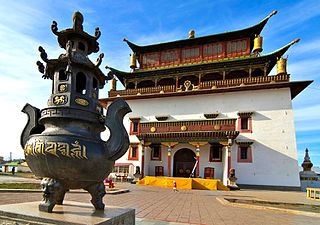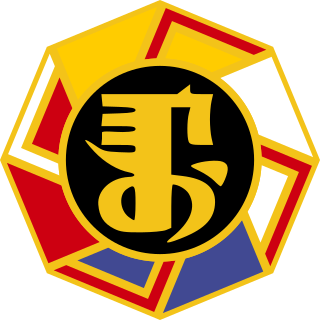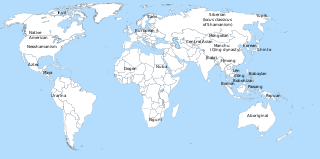Related Research Articles

Black magic, also known as dark magic, has traditionally referred to the use of supernatural powers or magic for evil and selfish purposes, specifically the seven magical arts prohibited by canon law, as expounded by Johannes Hartlieb in 1456. During his period of scholarship, A. E. Waite provided a comprehensive account of black magic practices, rituals and traditions in The Book of Ceremonial Magic (1911).
The Oroqen people are an ethnic group in northern China. They form one of the 56 ethnic groups officially recognized by the People's Republic of China. The Oroqen people are largely concentrated in the northern Chinese provinces of Heilongjiang and Inner Mongolia, which are home to 45.54% and 41.94% of the 8,659 Oroqen people living in China, respectively. The Oroqen Autonomous Banner is also located in Inner Mongolia.

The People's Republic of China is officially an atheist state, but the government formally recognizes five religions: Buddhism, Taoism, Christianity, and Islam. In the early 21st century, there has been increasing official recognition of Confucianism and Chinese folk religion as part of China's cultural inheritance. Chinese civilization has historically long been a cradle and host to a variety of the most enduring religio-philosophical traditions of the world. Confucianism and Taoism (Daoism), later joined by Buddhism, constitute the "three teachings" that have shaped Chinese culture. There are no clear boundaries between these intertwined religious systems, which do not claim to be exclusive, and elements of each enrich popular or folk religion. The emperors of China claimed the Mandate of Heaven and participated in Chinese religious practices. In the early 20th century, reform-minded officials and intellectuals attacked all religions as "superstitious"; since 1949, China has been governed by the CCP, a Marxist–Leninist atheist institution that prohibits party members from practicing religion while in office. In the culmination of a series of atheistic and anti-religious campaigns already underway since the late 19th century, the Cultural Revolution against old habits, ideas, customs, and culture, lasting from 1966 to 1976, destroyed or forced them underground. Under subsequent leaders, religious organisations have been given more autonomy.

Tengrism is an ethnic and old state Turko-Mongolic religion originating in the Eurasian steppes, based on folk shamanism, animism and generally centered around the titular sky god Tengri. Tengri was not considered a deity in the usual sense, but a personification of the universe. The purpose of life is, according to the Tengris view, to live in harmony with the universe.

In the Vedic Hinduism, a homa also known as havan, is a fire ritual performed on special occasions by a Hindu priest usually for a homeowner. The grihasth keeps different kinds of fire including one to cook food, heat his home, amongst other uses; therefore, a Yajna offering is made directly into the fire. A homa is sometimes called a "sacrifice ritual" because the fire destroys the offering, but a homa is more accurately a "votive ritual". The fire is the agent, and the offerings include those that are material and symbolic such as grains, ghee, milk, incense and seeds.
Noyan, or Toyon, was a Central Asian title of authority which was used to refer to civil-military leaders of noble ancestry in the Central Asian Khanates with origins in Noyon, which was used as a title of authority in the Chagatai Khanate of the Mongol Empire. In modern times, Noyan is used as a given name or surname in Asia and throughout Central Asia meaning "the lord", "the prince", "the protector", "the commander-in-chief".

Religion in Mongolia has been traditionally dominated by the schools of Mongolian Buddhism and by Mongolian shamanism, the ethnic religion of the Mongols. Historically, through their Mongol Empire the Mongols were exposed to the influences of Christianity and Islam, although these religions never came to dominate. During the communist period of the Mongolian People's Republic (1924–1992) all religions were suppressed, but with the transition to the parliamentary republic in the 1990s there has been a general revival of faiths.

Mongolian shamanism, more broadly called the Mongolian folk religion, or occasionally Tengerism, refers to the animistic and shamanic ethnic religion that has been practiced in Mongolia and its surrounding areas at least since the age of recorded history. In the earliest known stages it was intricately tied to all other aspects of social life and to the tribal organization of Mongolian society. Along the way, it has become influenced by and mingled with Buddhism. During the socialist years of the twentieth century, it was heavily repressed, but has since made a comeback.
In the pantheon of Mongolian shamanism and Tengrism, tngri constitute the highest class of divinities and are attested in sources going back to the 13th century. They are led by different chief deities in different documents and are divided into a number of different groups—including black (terrifying) and white (benevolent), and eastern and western. While there generally seem to be 99 tngri, some documents propose three others, and while they are generally the highest divinities, some liturgical texts propose an additional group of 33 chief gods alongside the tngri. They were invoked only by the highest shamans and leaders for special occasions; they continue to be venerated especially in black shamanism. Chief among the tngri are Qormusata Tngri and (Khan) Möngke Tngri.
Black shamanism is a kind of shamanism practiced in Mongolia and Siberia. It is specifically opposed to yellow shamanism, which incorporates rituals and traditions from Buddhism. Black Shamans are usually perceived as working with evil spirits, while white Shamans with spirits of the upper world.
Daichsun Tngri, also known as Dayisud Tngri and Dayičin Tngri, is a Mongolian war god "of a protective function" to whom captured enemies were sometimes sacrificed. One of the equestrian deities within the Mongolian pantheon of 99 tngri, Dayisun Tngri may appear as a mounted warrior. Some of his characteristics may be the result of the "syncretistic influence of Lamaism" ; the 5th Dalai Lama composed invocations to this deity.

Sülde Tngri is an equestrian war god, one of the tngri, the highest group of divinities in Mongolian shamanism and Buddhism. He is usually depicted as an armored warrior riding a horse. In Mongolian shamanism, everyone possesses a guardian spirit, called a sülde. "Sülde Tngri" can refer to the sülde of any great leader, but it primarily refers to the deified sülde of Genghis Khan. As a war god, Sülde Tngri's primary function is protecting his devotees from their enemies and aiding them in battles against their foes.
Qormusta Tengri (Cyrillic: Хурмаста, Хормуста-тенгри, Хан-Хурмаста; from the Sogdian Хурмазта/Khurmazta; also transliterated as Qormusata (Tngri), Khormusta (Tngri), Hormusta (Tngri), and Qormusda (Tngri)) is a god in Tengrism and shamanism, described as the chief god of the 99 tngri and leader of the 33 gods. Hormusta is the counterpart of the Turkic deities, Hürmüz and Kormos Khan.
Buddhism in Buryatia—a regional form of Buddhism.

Manchu folk religion or Manchu traditional religion is the ethnic religion practiced by most of the Manchu people, the major Tungusic group in China. It can also be called Manchu shamanism by virtue of the word "shaman" being originally from Tungusic šamán, later applied by Western scholars to similar religious practices in other cultures.

Qiang folk religion is the indigenous religion of the majority of the Qiang people, an ethnic group of Sichuan (China) tightly related to the Han Chinese and the Tibetans. It is pantheistic, involving the worship of a variety of gods of nature and of human affairs, including Qiang progenitors. White stones are worshipped as it is believed they can be invested with the power of some gods through rituals. They believe in an overarching God, called Mubyasei, which is connected to the Chinese concept of Tian and clearly identified by the Qiang with the Taoist-originated Jade Emperor.
Davaajargal Tsaschikher, also known as Davaa, is a Mongolian sound artist and the lead vocalist of the experimental rock band Mohanik.
Munkhbolor Ganbold, also known as Munkkh, is a Mongolian contemporary artist who was one of the participating artists of the Mongolia Pavilion — Lost in Tngri at the 57th La Biennale di Venezia.

Shamanism is a religious practice present in various cultures and religions around the world. Shamanism takes on many different forms that vary greatly by region and culture, shaped by the distinct histories of its practitioners.
Arshi is a name, and may refer to:
References
- ↑ Atwood, Christopher P. (1996). "Buddhism and Popular Ritual in Mongolian Religion: A Reexamination of the Fire cult". History of Religions : 112–39. JSTOR 3176686.